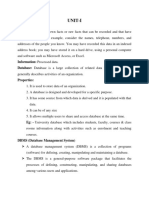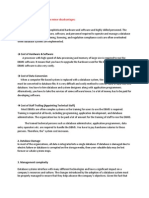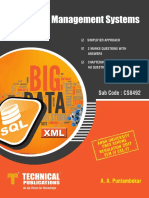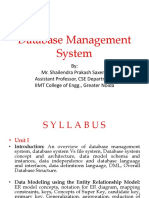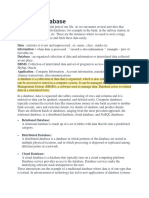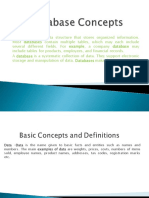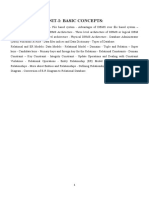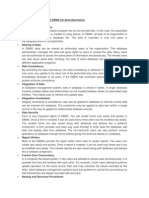0 ratings0% found this document useful (0 votes) 190 views26 pagesFyit Dbms Unit 1 Notes-1
Copyright
© © All Rights Reserved
We take content rights seriously. If you suspect this is your content,
claim it here.
Available Formats
Download as PDF or read online on Scribd
FY.LT. Semester
Fundamentals of Database Management System
What is Data?
Collection of unorganized raw facts known as data such as values or measurements,
Data cau be in the form of
‘Text - Text includes combination of alphabets in small case as well as upper case
‘Numbers - Numbers include combination of digits from 0 to 9.
Images
Audio
Video
What is a Database?
* A database is collection of organized and meaningful data
‘¢ It canalso be described as the activities of one or more related organizations
¢ Databases are being used more than ever before, for storing and accessing information,
A database has following properties:
It represents some aspects of real world.
Itis a logically connected collection of data which has. certain meaning.
Its created, maintained and populated with data for a specific purpose
Itean be of any size and complexity.
‘The information in a database must be organized and managed properly so that it can be used by
any ser at any given time.
A database can be created and maintained mannally ot computerized.
A computerized database is created and maintained either by a group of application programs for
performing a specific task or by a database management system.
Database Management System:
‘¢ A Software designed to store, manipulate and retrieve data in a database is called a Database
Management System (DBMS). e.g., Dbase III+, Foxbase, FoxPro, SQL etc.
ADBNS also can be described as a set of programs to use and/or modify this data
It is a general-purpose software system that helps to define, construct, manipulate and share
databases amongst vatious users and applications.
The DBMS is a central system which provides a common interface between the data and the
various front-end programs in the application.
'# Italso provides a central location for the whole data in the application to reside.
Need of DBMS.
1) Large size of data — Small amount of data can be stored on spreadsheets but storing large amount of
data on spreadsheet can create a problem. DBMS is a solution for this problem.
2) Easy updating of data — In DBMS multiple people can update or access the data from one database
ata time whieh is not the possible with the file system.
3) Need of accuracy ~ In files, the data validation is not possible and hence there are chances of wrong,
data entry which ean be avoided in the DBMS.
4) Security requirements ~ To secure data in a file system is the biggest problem which is taken care of
in the DBMS by using access control methods,
5) Incomplete data problems — The duplication of data is a one of the major issue faced in the file
system, Since DBMS has various techniques and methods to avoid the duplication of data,
incompleteness of data ete,
Notes By Prof. Dhanshree ingle and Prof. Anjali Dandekar�9
FYALT. Semester |
Fundamentals of Database Management System
To remove redundancy ~ In DBMS data validation techniques helps to coutrol data redundancy
which is not possible with the file system,
Applications of Database Management System
yD
2
32)
a
5)
9
0
8)
9
‘Banking: For customer information, accounts, loans, and banking transactions
Airlines: For reservations and schedule information, Airlines were among the fitst to use databases in.
1 geographically distributed manner
Universities: For student information/ course registrations, and grades.
Credit card transactions: For purchases on credit cards and generation of monthly statements.
‘Telecommunication: for keeping records of calls made, generating monthly bills, maintaining balances
‘on prepaid calling cards, and storing information about the communication networks,
Finance: for storing information about holdings, sales, and purchases of financial instruments such as
stocks and bonds; also for storing real-time market data to enable on-line trading by customers and
automated trading by the firm,
Sales: For customer, product, and purchase information,
On-line retailers: For sales data noted above plus on-line order tracking/ generation of recommendation
lists, and maintenance of on-line product evaluations,
‘Manufacturing: For management of the supply chain and for tracking production of items in factories,
inventories of items in warehouses and stores, and orders for items,
10)Human resources: For information about employees, salaries, payroll taxes, benefits, and for
generation of paychecks
Purpose of Database Management System/ Disadvantages of File System
»
2
3)
Data redundancy and inconsistency:
© Since different programmers create the files and application programs over a long period, the
various files are likely to have different structures and the programs may be written in several
programming languages,
‘¢ Therefore, the same information may be duplicated in several places (files).
‘¢ This redundancy leads to higher storage and access cost
‘¢ Inaddition, it may lead to data inconsistency; that is, the various copies of the same data may no
longer agree.
Difficulty in accessing data
‘* The conventional file-processing environments do not allow needed data to be retrieved in a
convenient and efficient manner
For Example, consider that one of the university clerks needs to find out the names of all students
who live within a particular postal-code area. The clerk asks the data-processing department to
generate such a lis.
‘* Because the designers of the original system did not anticipate this request, there is no application
program on hand to meet it.
‘¢. There is, however, an application program to generate the list ofall students.
¢ The university clerk has now two choices: either obtain the list of all students and extract the
needed information manually or ask a programmer to write the necessary application program,
Both altematives are obviously unsatisfactory.
¢ Therefore extraction of the required data is difficult.
Data isolation:
# Because data are scattered in various files, and files may be in different formats, writing new
application programs to retrieve the appropriate data is difficult.
Notes By Prof. Dhanshree ingle and Prof. Anjali Dandekar�FYALT. Semester |
Fundamentals of Database Management System
4) Integrity problems:
‘¢ The data values stored in the database must satisfy certain types of consistency constraints
‘© Suppose the university maintains an account for each department, and records the balance amount
in each account.
5) Integrity problems
‘¢ Suppose also that the university requires that the account balance of a department may never fall
below zero.
'* Developers enforce these constraints in the system by adding appropriate code in the various
application programs.
‘# However, when new constraints are added, itis difficult to change the programs to enforce them,
‘¢ The problem is compounded when constraints involve several data items from different files,
6) Atomicity problems:
‘* Acomputer system, like any other device, is subject to failure.
‘¢ Inmany applications, itis crucial that, if a failure occurs, the data be restored to the consistent state
that existed prior to the failure.
‘© Itis difficutt to ensure atomicity in a conventional file-processing system.
7) Concurrent-access anomalies:
‘* To increase the overall performance of the system and faster response, many systems allow
ultiple users to update the data simultaneously.
‘* _Insuch an environment, interaction of concurrent updates is possible and may result in inconsistent
data.
8) Security problems
‘¢ Not every user of the database system should be able to access all the data
‘© since application programs até added to the file-processing system in an ad hoc manner, enforcing
such security constraints is difficult,
Advantages of Database Management System
1) Minimized data inconsistency. Data inconsistency exists when different versions of the same data
appear in different places. The probability of data inconsistency is greatly reduced in a properly
designed database.
2) Reduction in data Redundancy: When working with a structured database, DBMS provides the
feature to prevent the input of duplicate items in the database. for e.g — If there are two same
students in different rows, then one of the duplicate data will be deleted.
3) Data sharing: A DBMS provides a platform for sharing data across multiple applications and
users, which can increase productivity and collaboration.
4) Simple: Database management system (DBMS) gives a simple and clear logical view of data.
Many operations like insertion, deletion, or creation of files or data are easy to implement.
5) Data abstraction: The major purpose of a database system is to provide users with an abstract,
view of the data, Since many complex algorithms are used by the developers to inerease the
efficiency of databases that are being hidden by the users through various data abstraction levels.
toallow users to easily interact with the system.
6) The atomicity of data can be maintained: That means, if some operation is
performed on one particular table of the database, then the change must be reflected for the
entire database.
7) Concurrency Control-The DBMS allows concurrent access to multiple users by using the
synchronization technique
Notes By Prof. Dhanshree Ingle and Prof. Anjali Dandeker



